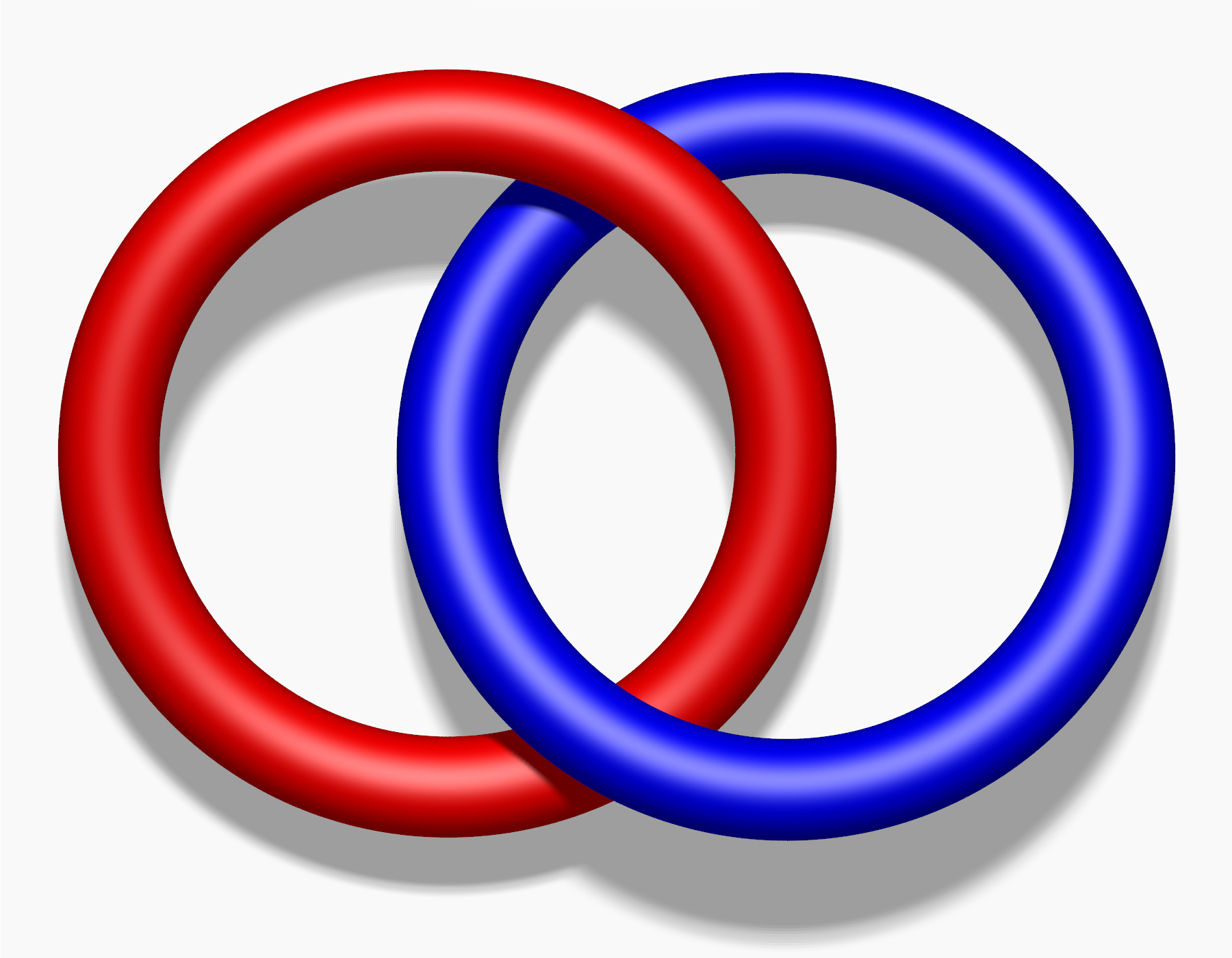|
Tait Conjectures
The Tait conjectures are three conjectures made by 19th-century mathematician Peter Guthrie Tait in his study of knots.. The Tait conjectures involve concepts in knot theory such as alternating knots, chirality, and writhe. All of the Tait conjectures have been solved, the most recent being the Flyping conjecture. Background Tait came up with his conjectures after his attempt to tabulate all knots in the late 19th century. As a founder of the field of knot theory, his work lacks a mathematically rigorous framework, and it is unclear whether he intended the conjectures to apply to all knots, or just to alternating knots. It turns out that most of them are only true for alternating knots. In the Tait conjectures, a knot diagram is called "reduced" if all the "isthmi", or "nugatory crossings" have been removed. Crossing number of alternating knots Tait conjectured that in certain circumstances, crossing number was a knot invariant, specifically: Any reduced diagram of an alter ... [...More Info...] [...Related Items...] OR: [Wikipedia] [Google] [Baidu] |
Peter Guthrie Tait
Peter Guthrie Tait FRSE (28 April 1831 – 4 July 1901) was a Scottish mathematical physicist and early pioneer in thermodynamics. He is best known for the mathematical physics textbook ''Treatise on Natural Philosophy'', which he co-wrote with Lord Kelvin, and his early investigations into knot theory. His work on knot theory contributed to the eventual formation of topology as a mathematical discipline. His name is known in graph theory mainly for Tait's conjecture. He is also one of the namesakes of the Tait–Kneser theorem on osculating circles. Early life Tait was born in Dalkeith on 28 April 1831 the only son of Mary Ronaldson and John Tait, secretary to the 5th Duke of Buccleuch. He was educated at Dalkeith Grammar School then Edinburgh Academy. He studied Mathematics and Physics at the University of Edinburgh, and then went to Peterhouse, Cambridge, graduating as senior wrangler and first Smith's prizeman in 1852. As a fellow and lecturer of his college he rema ... [...More Info...] [...Related Items...] OR: [Wikipedia] [Google] [Baidu] |
Jones Polynomial
In the mathematical field of knot theory, the Jones polynomial is a knot polynomial discovered by Vaughan Jones in 1984. Specifically, it is an invariant of an oriented knot or link which assigns to each oriented knot or link a Laurent polynomial in the variable t^ with integer coefficients. Definition by the bracket Suppose we have an oriented link L, given as a knot diagram. We will define the Jones polynomial, V(L), using Louis Kauffman's bracket polynomial, which we denote by \langle~\rangle. Here the bracket polynomial is a Laurent polynomial in the variable A with integer coefficients. First, we define the auxiliary polynomial (also known as the normalized bracket polynomial) :X(L) = (-A^3)^\langle L \rangle, where w(L) denotes the writhe of L in its given diagram. The writhe of a diagram is the number of positive crossings (L_ in the figure below) minus the number of negative crossings (L_). The writhe is not a knot invariant. X(L) is a knot invariant since ... [...More Info...] [...Related Items...] OR: [Wikipedia] [Google] [Baidu] |
Tangle (knot Theory)
In mathematics, a tangle is generally one of two related concepts: * In John Conway's definition, an ''n''-tangle is a proper embedding of the disjoint union of ''n'' arcs into a 3-ball; the embedding must send the endpoints of the arcs to 2''n'' marked points on the ball's boundary. * In link theory, a tangle is an embedding of ''n'' arcs and ''m'' circles into \mathbf^2 \times ,1/math> – the difference from the previous definition is that it includes circles as well as arcs, and partitions the boundary into two (isomorphic) pieces, which is algebraically more convenient – it allows one to add tangles by stacking them, for instance. (A quite different use of 'tangle' appears in Graph minors X. Obstructions to tree-decomposition by N. Robertson and P. D. Seymour, ''Journal of Combinatorial Theory'' B 52 (1991) 153–190, who used it to describe separation in graphs. This usage has been extended to matroids.) The balance of this article discusses Conway's sense of tangles; fo ... [...More Info...] [...Related Items...] OR: [Wikipedia] [Google] [Baidu] |
Prime Knot
In knot theory, a prime knot or prime link is a knot that is, in a certain sense, indecomposable. Specifically, it is a non- trivial knot which cannot be written as the knot sum of two non-trivial knots. Knots that are not prime are said to be composite knots or composite links. It can be a nontrivial problem to determine whether a given knot is prime or not. A family of examples of prime knots are the torus knots. These are formed by wrapping a circle around a torus ''p'' times in one direction and ''q'' times in the other, where ''p'' and ''q'' are coprime integers. Knots are characterized by their crossing numbers. The simplest prime knot is the trefoil with three crossings. The trefoil is actually a (2, 3)-torus knot. The figure-eight knot, with four crossings, is the simplest non-torus knot. For any positive integer ''n'', there are a finite number of prime knots with ''n'' crossings. The first few values are given in the following table. : Enantiomorphs are co ... [...More Info...] [...Related Items...] OR: [Wikipedia] [Google] [Baidu] |
Chirality (mathematics)
In geometry, a figure is chiral (and said to have chirality) if it is not identical to its mirror image, or, more precisely, if it cannot be mapped to its mirror image by rotations and translations alone. An object that is not chiral is said to be ''achiral''. A chiral object and its mirror image are said to be enantiomorphs. The word ''chirality'' is derived from the Greek (cheir), the hand, the most familiar chiral object; the word ''enantiomorph'' stems from the Greek (enantios) 'opposite' + (morphe) 'form'. Examples Some chiral three-dimensional objects, such as the helix, can be assigned a right or left handedness, according to the right-hand rule. Many other familiar objects exhibit the same chiral symmetry of the human body, such as gloves and shoes. Right shoes differ from left shoes only by being mirror images of each other. In contrast thin gloves may not be considered chiral if you can wear them inside-out. The J, L, S and Z-shaped '' tetrominoes'' of the pop ... [...More Info...] [...Related Items...] OR: [Wikipedia] [Google] [Baidu] |
Perko Pair
In the mathematical theory of knots, the Perko pair, named after Kenneth Perko, is a pair of entries in classical knot tables that actually represent the same knot. In Dale Rolfsen's knot table, this supposed pair of distinct knots is labeled 10161 and 10162. In 1973, while working to complete the classification by knot type of the Tait–Little knot tables of knots up to 10 crossings (dating from the late 19th century), Perko found the duplication in Charles Newton Little's table. This duplication had been missed by John Horton Conway several years before in his knot table and subsequently found its way into Rolfsen's table. The Perko pair gives a counterexample to a "theorem" claimed by Little in 1900 that the writhe In knot theory, there are several competing notions of the quantity writhe, or \operatorname. In one sense, it is purely a property of an oriented link diagram and assumes integer values. In another sense, it is a quantity that describes the amoun ... of a r ... [...More Info...] [...Related Items...] OR: [Wikipedia] [Google] [Baidu] |
Knot (mathematics)
In mathematics, a knot is an embedding of the circle into three-dimensional Euclidean space, (also known as ). Often two knots are considered equivalent if they are ambient isotopic, that is, if there exists a continuous deformation of which takes one knot to the other. A crucial difference between the standard mathematical and conventional notions of a knot is that mathematical knots are closed — there are no ends to tie or untie on a mathematical knot. Physical properties such as friction and thickness also do not apply, although there are mathematical definitions of a knot that take such properties into account. The term ''knot'' is also applied to embeddings of in , especially in the case . The branch of mathematics that studies knots is known as knot theory and has many relations to graph theory. Formal definition A knot is an embedding of the circle () into three-dimensional Euclidean space (), or the 3-sphere (), since the 3-sphere is compact. Two knots ar ... [...More Info...] [...Related Items...] OR: [Wikipedia] [Google] [Baidu] |
William Menasco
William W. Menasco is a topologist and a professor at the University at Buffalo. He is best known for his work in knot theory. Biography Menasco received his B.A. from the University of California, Los Angeles in 1975, and his Ph.D. from the University of California, Berkeley in 1981, where his advisor was Robion Kirby. He served as assistant professor at Rutgers University from 1981 to 1984. He then taught as a visiting professor at the University at Buffalo where he became an assistant professor in 1985, an associate professor in 1991. In 1994 he became a professor at the University at Buffalo where he currently serves. Work Menasco proved that a link with an alternating diagram, such as an alternating link, will be non-split if and only if the diagram is connected. Menasco, along with Morwen Thistlethwaite proved the Tait flyping conjecture, which states that, given any two reduced alternating diagrams D1,D2 of an oriented, prime alternating link Alternating may refer to: ... [...More Info...] [...Related Items...] OR: [Wikipedia] [Google] [Baidu] |
Flype
In the mathematical theory of knots, a flype is a kind of manipulation of knot and link diagrams used in the Tait flyping conjecture. It consists of twisting a part of a knot, a tangle T, by 180 degrees. Flype comes from a Scots word meaning ''to fold'' or ''to turn back'' ("as with a sock").. Tait used the term to mean, "a change of infinite complementary region"). Two reduced alternating diagrams of an alternating link can be transformed to each other using flypes. This is the Tait flyping conjecture, proven in 1991 by Morwen Thistlethwaite and William Menasco. See also * Reidemeister move Kurt Werner Friedrich Reidemeister (13 October 1893 – 8 July 1971) was a mathematician born in Braunschweig (Brunswick), Germany. Life He was a brother of Marie Neurath. Beginning in 1912, he studied in Freiburg, Munich, Marburg, and Götting ...s are another commonly studied kind of manipulation to knot diagrams. References Knot operations {{knottheory-stub ... [...More Info...] [...Related Items...] OR: [Wikipedia] [Google] [Baidu] |
Joshua Greene (mathematician)
{{hndis, Greene, Joshua ...
Joshua or Josh Greene may refer to: *Joshua Greene (psychologist), experimental psychologist at Harvard University * Joshua Greene (wine), wine critic, publisher and editor-in-chief of ''Wine & Spirits'' * Josh Greene (artist), American conceptual artist See also *Joshua Green (other) Joshua or Josh Green may refer to: * Joshua Green (businessman) (1869–1975), prominent figure in the history of Seattle, Washington * Joshua Green (journalist) (born 1972), American journalist and editor * Josh Green (baseball) * Josh Green (ba ... [...More Info...] [...Related Items...] OR: [Wikipedia] [Google] [Baidu] |
Topology (journal)
''Topology'' was a peer-reviewed mathematical journal covering topology and geometry. It was established in 1962 and was published by Elsevier. The last issue of ''Topology'' appeared in 2009. Pricing dispute On 10 August 2006, after months of unsuccessful negotiations with Elsevier about the price policy of library subscriptions, the entire editorial board of the journal handed in their resignation, effective 31 December 2006. Subsequently, two more issues appeared in 2007 with papers that had been accepted before the resignation of the editors. In early January the former editors instructed Elsevier to remove their names from the website of the journal, but Elsevier refused to comply, justifying their decision by saying that the editorial board should remain on the journal until all of the papers accepted during its tenure had been published. In 2007 the former editors of ''Topology'' announced the launch of the '' Journal of Topology'', published by Oxford University Press ... [...More Info...] [...Related Items...] OR: [Wikipedia] [Google] [Baidu] |



